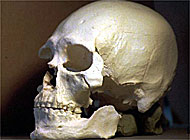Sense and sensibility come to Basel

Basel's anatomical museum confronts the visitor with death and dying but also celebrates the remarkable workings of the human body.
The museum, which is currently hosting a temporary exhibition called World of the Senses, was founded in the late 19th century.
The oldest exhibit in the permanent collection is a skeleton from 1543. Other highlights include cross sectional slices, just 10 centimetres thick, through the entire human body.
A rare inverse body is also on display – all the organs from the heart to the appendix are on the opposite side from which they usually appear.
“We actually have very few abnormalities,” says Professor Udo Spornitz, who works at the adjacent Anatomical Institute.
“What we have – and I think this is also an expression of the frequency of their occurrence – are abnormal foetuses or miscarriage. But on the whole, we are a museum of the normal human body structures.”
The institute receives about 10 to 12 bodies a year for use in students’ dissection courses. People who choose to donate their bodies must state this expressly in their will.
As for conservation techniques, surprisingly little has changed in the past 50 years though there has been one major development, says Spornitz.
“Nowadays you can not only conserve a body but you can conserve it in its original colours. When you go to other museums, you frequently find that the muscle is grey and not red like we are used to.
“The technique that we use here really renders specimens in their original colour and that is a major improvement.”
Spornitz says the workings of the human body never cease to amaze him, whether it’s the ingenuity of the eye or the pumping of the heart. “When we look at the valves of the heart, it is incredible to believe that artificial valves, which look much sturdier than the human valves, don’t last as long,” he says.
“The human heart can pump thousands and thousands of litres a day and do that for over 80 years. That’s fascinating.”
by Vincent Landon

In compliance with the JTI standards
More: SWI swissinfo.ch certified by the Journalism Trust Initiative
You can find an overview of ongoing debates with our journalists here. Please join us!
If you want to start a conversation about a topic raised in this article or want to report factual errors, email us at english@swissinfo.ch.